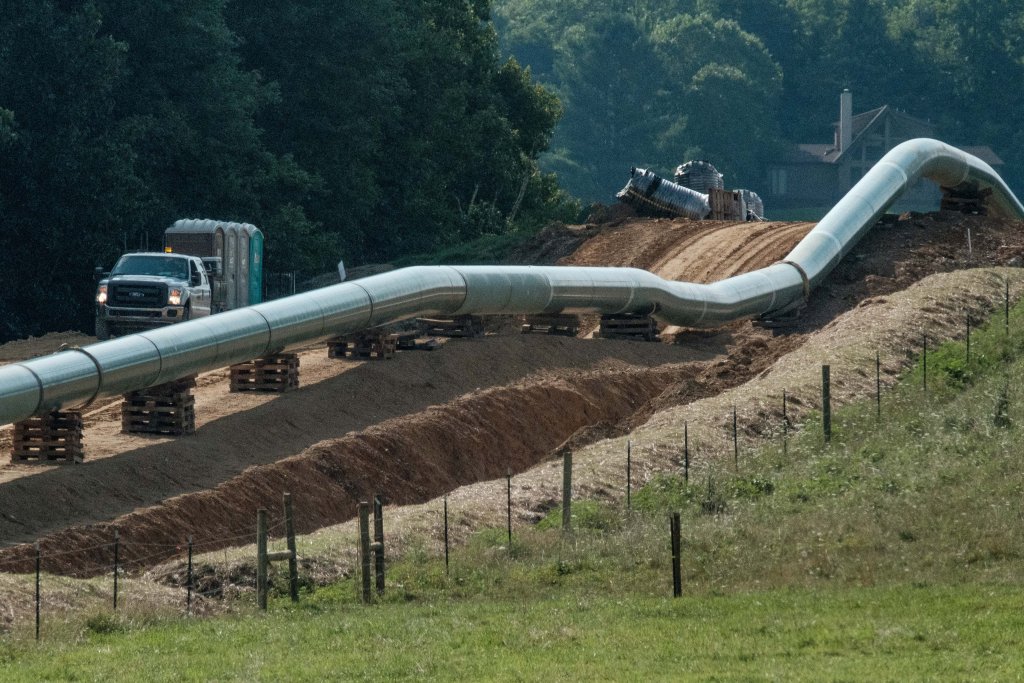The Mountain Valley Pipeline in Roanoke County, pictured in 2018. (Ned Oliver/Virginia Mercury)
A third-party report commissioned by Mountain Valley Pipeline developers has found the cause of a test failure in May was due to a manufacturer defect and not corrosion issues, a concern environmental advocates have continuously raised about the project that took about a decade to complete before coming online earlier this year.
The report, from DNV GL USA, found that a manufacturing “buttwelding” for the .7-inch thick elbow fitting installed in June 2018 blew before the hydrostatic testing reached desired pressure, weeks before the project went into service.
“From a manufacturing perspective, the failed fitting had a “sister” fitting in the same test section that was proactively removed from the pipeline and used to provide material for a portion of the mechanical testing aspect of the failure analysis,” wrote Justin Trettlel, in an letter to the Federal Energy Regulatory Commission accompanying the report. “There were only two fittings with matching pedigree, neither of which remains in the pipeline.”
The 303-mile Mountain Valley Pipeline went online in June with the capacity to deliver up to 2 billion cubic feet of natural gas from the Marcellus and Utica Shales of West Virginia into Pittsylvania County in Southwest Virginia. First announced in 2014, the project faced mounting legal troubles over environmental issues until West Virginia Democratic Sen. Joe Manchin included in a federal spending plan a provision to greenlight the project to completion and end any legal disputes until it is built.
Environmental groups said those delays caused possible corrosion issues with the pipe, as a result of laying out of the ground and exposed to the elements for years. But, the analysis from DNV that involved visually inspecting the pipe and metallurgical tests found that the failure was “a result of ductile overload,” meaning the pipe’s strength was exceeded.
“There was no evidence of external or internal corrosion,” the report states underneath a picture of the ruptured pipe. “The external coating was adhered except for some portions adjacent to the fracture surfaces that disbanded due to the rupture.”
A picture of the Mountain Valley Pipeline piece that failed during a test. (Courtesy of DNV GL USA report)
At the time of the test failure, a Mountain Valley Pipeline spokeswoman said that “disruption of this one hydrotest does, in fact, demonstrate that the testing process is working as designed and intended.”
Russell Chisholm, co-director of the Protect Our Water, Heritage, Rights Coalition (POWHR), a group staunchly opposed to the project, said in a statement the report comes after “four months of waiting.”
“This is a pathetically predictable outcome; we know the MVP has used shoddy materials for their rushed construction job on this massive methane pipeline project,” Chisholm said. “This is yet more evidence of the threat MVP poses to everyone along the route, and why the government never should have greenlit this corrupt project.”
The pipeline had received a consent agreement with the federal Pipeline and Hazardous Material Administration over safety concerns prior to starting service, but the agency said it had “no objections” if FERC approved the project starting. In July, the Virginia Department of Environmental Quality fined Mountain Valley $30,500 for erosion and sediment issues that predated the commencing of the project.
GET THE MORNING HEADLINES DELIVERED TO YOUR INBOX

